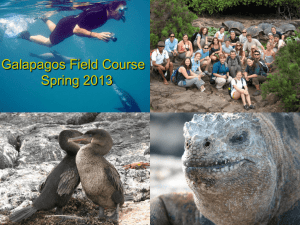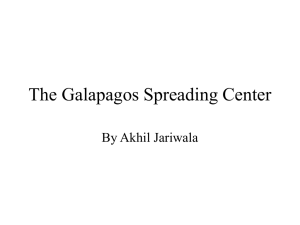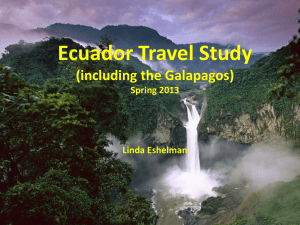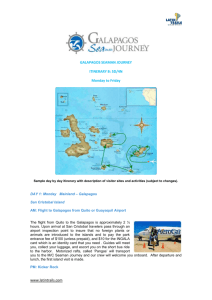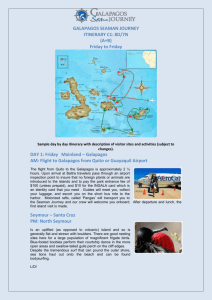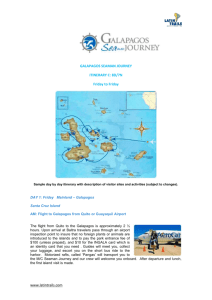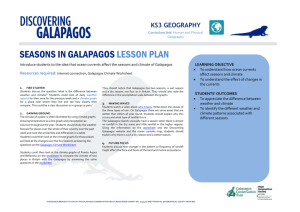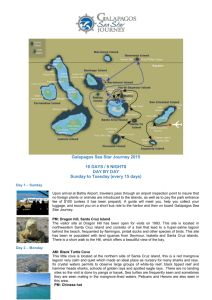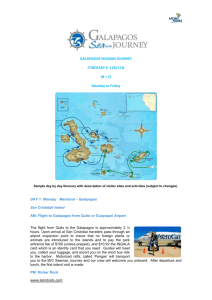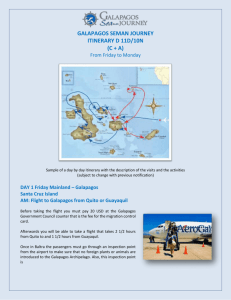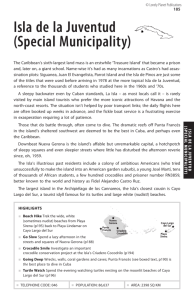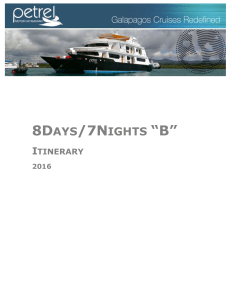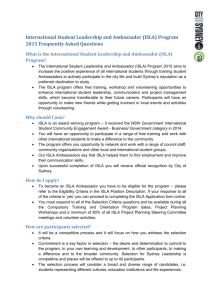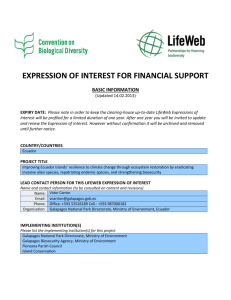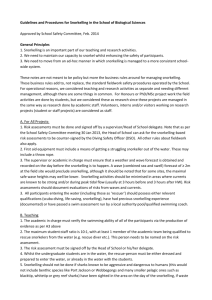galapagos photo expedition with darren jew
advertisement
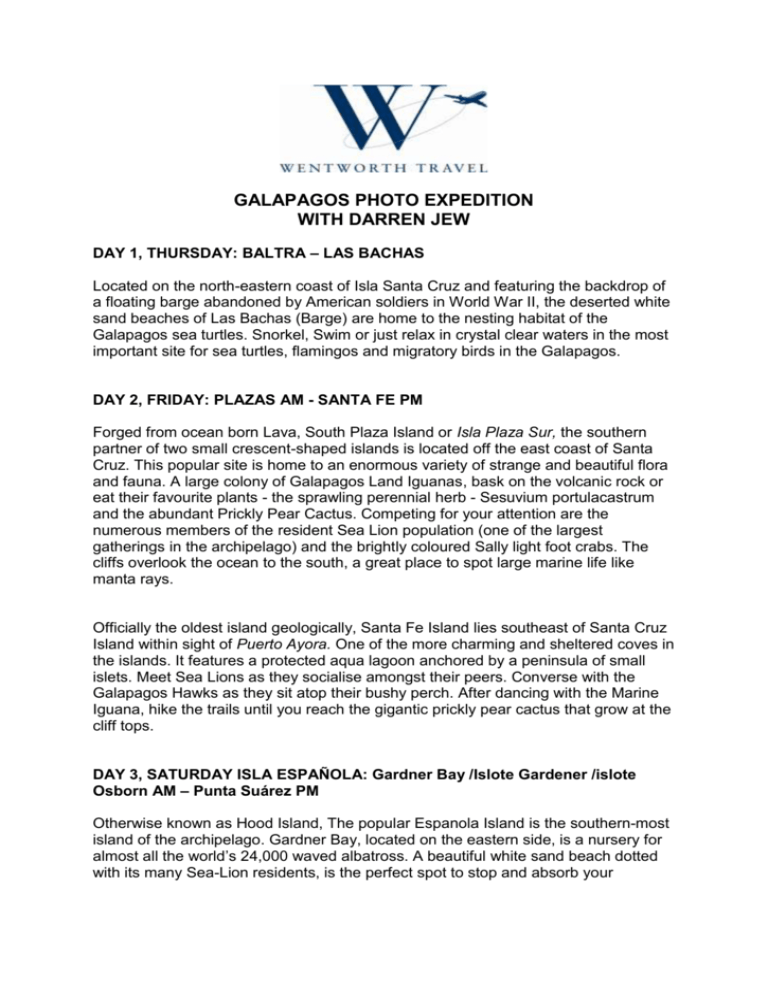
GALAPAGOS PHOTO EXPEDITION WITH DARREN JEW DAY 1, THURSDAY: BALTRA – LAS BACHAS Located on the north-eastern coast of Isla Santa Cruz and featuring the backdrop of a floating barge abandoned by American soldiers in World War II, the deserted white sand beaches of Las Bachas (Barge) are home to the nesting habitat of the Galapagos sea turtles. Snorkel, Swim or just relax in crystal clear waters in the most important site for sea turtles, flamingos and migratory birds in the Galapagos. DAY 2, FRIDAY: PLAZAS AM - SANTA FE PM Forged from ocean born Lava, South Plaza Island or Isla Plaza Sur, the southern partner of two small crescent-shaped islands is located off the east coast of Santa Cruz. This popular site is home to an enormous variety of strange and beautiful flora and fauna. A large colony of Galapagos Land Iguanas, bask on the volcanic rock or eat their favourite plants - the sprawling perennial herb - Sesuvium portulacastrum and the abundant Prickly Pear Cactus. Competing for your attention are the numerous members of the resident Sea Lion population (one of the largest gatherings in the archipelago) and the brightly coloured Sally light foot crabs. The cliffs overlook the ocean to the south, a great place to spot large marine life like manta rays. Officially the oldest island geologically, Santa Fe Island lies southeast of Santa Cruz Island within sight of Puerto Ayora. One of the more charming and sheltered coves in the islands. It features a protected aqua lagoon anchored by a peninsula of small islets. Meet Sea Lions as they socialise amongst their peers. Converse with the Galapagos Hawks as they sit atop their bushy perch. After dancing with the Marine Iguana, hike the trails until you reach the gigantic prickly pear cactus that grow at the cliff tops. DAY 3, SATURDAY ISLA ESPAÑOLA: Gardner Bay /Islote Gardener /islote Osborn AM – Punta Suárez PM Otherwise known as Hood Island, The popular Espanola Island is the southern-most island of the archipelago. Gardner Bay, located on the eastern side, is a nursery for almost all the world’s 24,000 waved albatross. A beautiful white sand beach dotted with its many Sea-Lion residents, is the perfect spot to stop and absorb your surroundings. Visitors can hike among the Mockingbirds and snorkel with the tropical fish along the rocky shore. The famous blowhole defines the incredible landscape of Suarez Point (Punta Suarez). The stunning ocean front is home to the large waved albatrosses and carnivorous Mockingbirds launching off the cliffs. An amazing array of exotic birds can be spotted while hiking this challenging terrain. A photographer’s paradise. DAY 4, SUNDAY ISLA FLOREANA: Post Office Bay AM – Punta Cormorant Devil`s Crown PM Famous for its unofficial mail box and mysterious history, Post Office Bay is located on the far south island of Floreana. 18th century whalers set up a barrel to send mail home on passing ships. The system still works. Leave a postcard, but make sure you take one from the barrel and see it delivered. Located on the north coast of Floreana Island, Punta Cormorant visitor site boasts a large flamingo lagoon also visited by other exotic birds. The beaches are also interesting. The sand glitters with a tint of green due to the volcanic olivine crystals present in the underlying geology. The best snorkelling in the Galapagos can be enjoyed around Isla Floreana, in particular the Devil's Crown. The volcanic crater has coral reef in its centre where you can swim with sharks, rays and tropical fish. DAY 5, MONDAY ISLA SANTA CRUZ: Charles Darwin Station AM – Crater Gemelos Highlands PM AM, CENTRO DE CRIANZA "FAUSTO LLERENA" (Charles Darwin Station) Home to many giant tortoises, the Charles Darwin Station offers visitors a unique experience. The older 4ft tortoises are accustomed to being around humans, so they're happy to stretch out their necks and pose for photos. Due to the breeding program, you can even see the baby tortoises. Formed by collapsing surface geology, Los Gemelos Pit Craters are not actually volcanic craters. Hike the circular path around the larger crater and through this incredible landscape to the Scalesia forest where visitors can observe some outstanding terrestrial land birds, especially the woodpecker finch and the vermillion flycatcher. DAY 6, TUESDAY ISLA SANTIAGO: Puerto Egas AM – Playa Espumilla /Caleta Bucanero PM Puerto Egas otherwise known as James Bay is the natural habit of the quizzical Galapagos hawk and the spritely Galapagos lava lizard. The interior of the site features stunning rock formations and hiking trails that lead toward the coast where lava flows have joined to create an amazing landscape. Snorkel with reef sharks, turtles and rays, or relax amongst the Galapagos fur seals as they play in the grottos and tide pools. Espumilla Beach is another fantastic snorkelling location. Spend time amongst the varied species including marine turtles, moray eels, sharks and octopus. Marine iguanas watch nearby as herons and pelicans hunt the Sally Lightfoot crabs. DAY 7, WEDNESDAY ISLOTE BARTOLOME AM – BAHIA SULLIVAN PM The Bartholomew Island visitor site is one of the jewels of the Galapagos. The famous Pinnacle Rock is the centre piece of an extraordinary landscape. Hike the extinct Volcano summit and enjoy the multi coloured lava formations and the spectacular views. More snorkelling is to be had on the perfect east side beach where Galapagos penguins band together on the rocks, sea lions snooze, and sea turtles nestle in the shallows - The south beach is accessed by a small path along the mangroves and over the great sand dunes. Covered in accordion style corrugated lava formations, Bahia Sullivan is a site of great geological significance. Locusts and lava lizards dot the blackened landscape as you look across the bay to an amazing view of Pinnacle Rock. This stunning volcanic site is an awesome reminder of the spectacular molten lava that once flowed here. DAY 8, THURSDAY ISLA NORTH SEYMOUR AM - BALTRA Formed by subaqueous lava flows and raised up by tectonic events, North Seymour Island is yet another haven for abundant wildlife. Land & marine iguanas and sea lions call this island home. Hike the trails and you may see blue-footed boobies perform their mating rituals or the mass feeding frenzies of the large flocks of seabirds. The Interior of the island provides magnificent frigate birds their largest nesting site in the Galapagos. Low lying bushes provide adult birds a perch to protect their chicks. This site brings another brilliant chance to snorkel - say hello to the local garden eels, reef sharks and rays and then it’s time to say farewell until next time.

